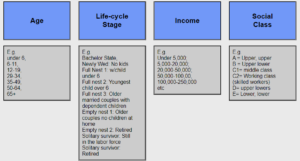Market Segmentation

There are many ways in which a market can be segmented. A marketer will need to decide which strategy is best for a given product or service. Sometimes the best option arises from using different strategies in conjunction. Approaches to segmentation result from answers to the following questions: where, who, why and how? Jon Weaver, Marketing Manager at Bournemouth Borough Council applies a multi-strategy approach to identify segments.

A market can be divided according to where consumers are located. On a trip abroad you might have noticed that people enjoy more outdoor activities than back home. You could also be surprised by the amount of people that like drinking hot coffee at the beach in Kompong Som. If you visit this website you will see differences in food preferences around the world.
Understanding cultural differences between countries could be pivotal for business success, consequently marketers will need to tailor their strategies according to where consumers are.
Geographic segmentation is the division of the market according to different geographical units like continents, countries, regions, counties or neighbourhoods. This form of segmentation provides the marketer with a quick snapshot of consumers within a delimited area.
Geographic segmentation can be a useful strategy to segment markets because it:
- provides a quick overview of differences and similarities between consumers according to geographical unit;
- can identify cultural differences between geographical units;
- takes into consideration climatic differences between geographical units;
- recognises language differences between geographical units.
- But this strategy fails to take into consideration other important variables such as personality, age and consumer lifestyles. Failing to recognise this could hinder a company’s potential for success.
For example some youth groups across the world appear to be somewhat similar. Youth groups will tend to listen to similar music and follow similar fashion trends. If you were to do a quick check of people’s nationalities in a 18s-30s club in Phnom Penh, you would find a very international clientele. You might have found that you can befriend foreign people of your same age easily because you share common interests.
A very popular form of dividing the market is through demographic variables. Understanding who consumers are will enable you to more closely identify and understand their needs, product and services usage rates and wants.
Understanding who consumers are requires companies to divide consumers into groups based on variables such as gender, age, income, social class, religion, race or family lifecycle [insert diagram g].
A clear advantage of this strategy over others is that there are vast amounts of secondary data available that will enable you to divide a market according to demographic variables

Unlike demographic segmentation strategies that describe who is purchasing a product or service, psycho-demographic segmentation attempts to answer the ‘why’s’ regarding consumer’s purchasing behaviour. Through this segmentation strategy markets are divided into groups based on personality, lifestyle and values variables.
Segmenting consumers into lifestyles is based on the notion that a person’s lifestyle has a direct impact on their interests in products and services.

Since personality traits have been correlated to (matched with) product categories consumers favour as well as persuasive appeals they respond to, marketers can use personality variables to segment their markets. Generally, this type of segmentation is successful for image-based products, such as cosmetics, clothing, jewellery, cigarettes, alcohol, mobile phones, etc.